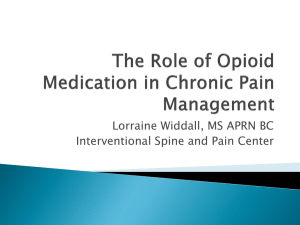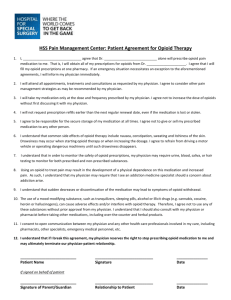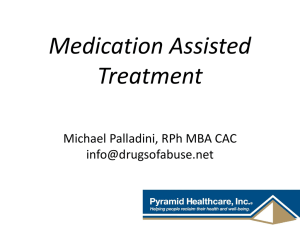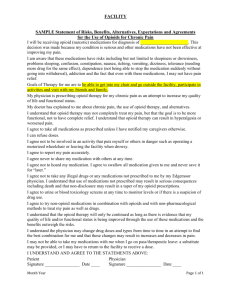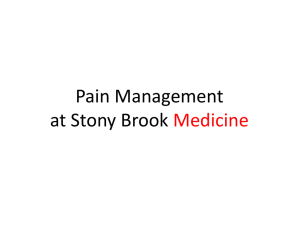317-944-1-RV - ASEAN Journal of Psychiatry
advertisement
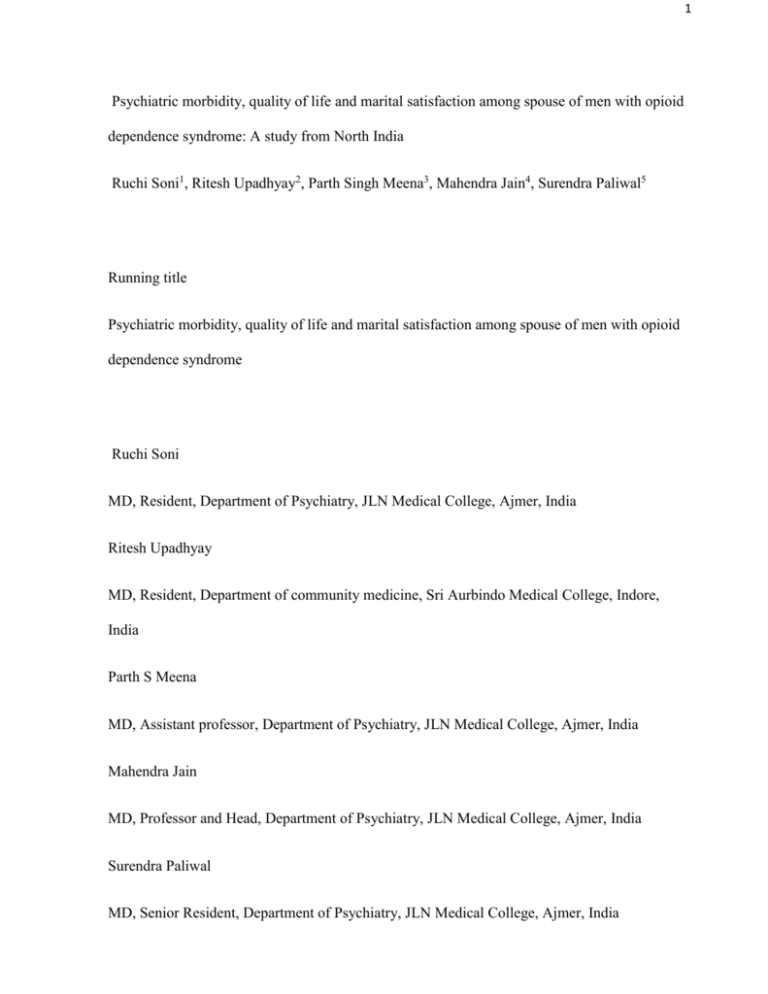
1 Psychiatric morbidity, quality of life and marital satisfaction among spouse of men with opioid dependence syndrome: A study from North India Ruchi Soni1, Ritesh Upadhyay2, Parth Singh Meena3, Mahendra Jain4, Surendra Paliwal5 Running title Psychiatric morbidity, quality of life and marital satisfaction among spouse of men with opioid dependence syndrome Ruchi Soni MD, Resident, Department of Psychiatry, JLN Medical College, Ajmer, India Ritesh Upadhyay MD, Resident, Department of community medicine, Sri Aurbindo Medical College, Indore, India Parth S Meena MD, Assistant professor, Department of Psychiatry, JLN Medical College, Ajmer, India Mahendra Jain MD, Professor and Head, Department of Psychiatry, JLN Medical College, Ajmer, India Surendra Paliwal MD, Senior Resident, Department of Psychiatry, JLN Medical College, Ajmer, India 2 Corresponding Author: Ruchi soni B-1 Janki Nagar Bhopal (M.P), India 462016 Email:dr.ruchi07@gmail.com Phone number: +918890840839 Statistical summary: Total words in abstract: 288 Total words in article excluding abstract and references: 3091 Number of references: 15 Number of tables: 5 ABSTRACT Objectives: Opioid dependence Syndrome has deleterious consequences not only on addict but also on the members of family especially his spouse who is most vulnerable to develop significant 3 psychiatric disorder given the intimate nature of their relationship. Addressing these issues will be beneficial as spouses are important source of moral support and assistance to the substance user’s quest toward abstinence with this aim current study was undertaken to assess the pattern of psychiatric morbidity, quality of life and marital satisfaction in spouses of men with opioid dependence syndrome. Materials and Methods: A cross sectional study was undertaken on 100 spouses of men with opioid dependence syndrome, subjects and controls (50 spouses of men who were not addicted to any substance) were assessed using a semi structured proforma, spouses were evaluated for psychiatric morbidity, Severity of opioid dependence in the husbands was assessed using severity of opioid dependence questioner (SODQ). Quality of life and Marital satisfaction was assessed using short form health survey 36 (SF 36) and marital satisfaction scale (MSS) respectively. Results: Data analysis reveals that 33% of spouses had a psychiatric disorder. Primarily mood and anxiety disorder was present in 22% and 9% of subjects respectively. Highly significant difference existed between cases and controls in terms of marital satisfaction (p=.0001) and quality of life (p= <0.05) indicating low marital satisfaction and poor quality of life in spouses of opioid dependent individuals. Conclusion: Psychological distress and psychiatric morbidity in spouses of opioid dependent men is high, with poor quality of marital life and marital satisfaction being low. Hence, interventions that aim at allaying their distress and improving their mental health can improve the condition of the substance user and contribute to a better outcome of substance abuse treatment. 4 Keywords: Marital satisfaction; psychiatric morbidity; spouses of men with opioid dependence Introduction Opioid dependence is a major public health problem around the world. Substance dependence has been linked to a family disease’ [1], suffered not only by the substance user but also by family members. The presence of a substance dependent person in the family increases conflicts and causes stress to every member of the family. This stress places all family members at risk for developing physical, psychological, social, and emotional problems. Data from treatment centres (Drug Abuse Monitoring System-DAMS) revealed that amongst all patients reporting for treatment, about 9% were opium users [2] .It is also a matter of concern that the annual rise in consumption is substantial and can have deleterious consequences not only on the addict but also on their spouses. Traditionally, studies on problems associated with opioid consumption have focused on the individual consuming opioids. In recent times however, concerns about the wider impact of opioid consumption have increased and have received some attention in research. Despite this there is striking paucity of studies pertaining to impact of addiction on spouses in psychiatric literature. Opioid consumption is considered as an on-going stressor, not only for the individual, but for family members as well. Spouses are particularly affected given the intimate nature of their relationship and constant exposure to the behaviour of the opioid dependent persons. The negative social consequences of opioid consumption and stressful life events may trigger psychological, biological, behavioural responses which interact to diminish the individual's 5 ability to adapt, leading to emotional distress and thereby increasing the likelihood of psychological problems. Spouses of opioid addicts are known to be exposed to high rates of domestic violence, which could be physical, verbal or sexual, low martial satisfaction, maladaptive coping skills and poor social support, in addition to economic burden and social stigma, are the other major issues among the spouses. Though significant levels of psychological distress seem to be apparent from such factors, surprisingly, very few studies have specifically explored this, either in Western or Indian research. Since each geographic region presents its own cultural advantages and peculiarities for substance use as well as familial interaction patterns, the results may not be generalizable. With psychological well-being comprised, spouses are likely to cope less efficiently, thereby adversely affecting their social and functional roles, as well as impacting the family harmony. Understanding and addressing the mental health issues of spouses of opioid addicts will not only decrease their burden, improve their coping skills, marital life and overall quality-of-life, but is also likely to have a bearing on the treatment and outcome of opioid addicts. . Hence, the present research was conducted on spouses of opioid dependent men for prevalence of psychiatric morbidity, quality of marital life and quality of life Material and Methods Settings After obtaining the required Institutional Ethical committee approval, the study was carried out at the Drug De-addiction and treatment centre (DDtc), Department of Psychiatry, at Jawahar Lal Nehru medical college Ajmer, during the period of September 2014 to March 2015. As part of a tertiary care institute, the DDtc provides inpatient and outpatient services for substance use disorders. The patients come by self-referral or referral from other hospitals or various clinical 6 departments; they are usually accompanied by their family members, including the spouses. Treatments offered include pharmacotherapy, psychotherapy and rehabilitation services. The inpatient care usually lasts three to four weeks; it focuses on detoxification, pharmacotherapy for withdrawal states, psychosocial rehabilitation and counselling for relapse prevention. Participants The study had a cross-sectional design. Married couples were recruited. The cases for the study constituted 100 spouses of patients with opioid dependence diagnosed according to ICD-10 criteria; recruitment was by purposive sampling for subjects fulfilling the specified inclusion and exclusion criteria as below: Inclusion criteria: 1) The wives of male adult inpatients with a diagnosis of Opioid Dependence Syndrome according to ICD-10 criteria. 2) Age group between 18 and 50years. Exclusion criteria: 1) Age below 18 and above 50 years 2) Physical and psychiatric disorders in the patient which are not related to opium use. 3) Spouses of patients not consenting for the study 4) Co-morbid substance use other than tobacco in the patients 50 spouses of healthy volunteers fulfilling similar inclusion and exclusion constituted the control group; they were group matched with spouses of opioid dependent subjects for age, education, domicile, religion, occupation, income and duration of marital life. Instruments Severity of opioid dependence in husbands was assessed using severity of opioid dependence questioner (SODQ). 7 Severity of Opioid Dependence Questionnaire (SODQ) is a measure to assess the severity of dependence on opioids among husbands. It consists of sixteen questions rated from zero (never) to three (always), with a maximum possible score of forty-eight. The scores correlate with subjective feelings of dependence. [3] Marital satisfaction among the spouses was assessed using the marital satisfaction scale (MSS). This scale has been developed and standardized for use among Indian population and has good validity and reliability. It has 30 items with three responses categories, which are scored as 0, 1 and 2. The maximum possible score on the scale is 60 and higher scores imply greater marital satisfaction. [4] Quality of life was assessed using, short-form health survey (SF-36) which is multipurpose with only 36 questions devised by John. E ware Jr. It yields an 8-scale profile of functional health and wellbeing scores as well as psychometrically based physical and mental health summary measures and a preference – based health utility index. It can be self-administered. It takes over 5-10 minutes for respondent to complete the scale. Scores can be transformed to make minimum and maximum possible scores of 0 and 100. Lower scores on SF-36 reflect poorer health, long standing illness and medical consultations in past 2 weeks. [5] Subjects was screened using the ICD-10 AM symptom checklist screener and were administered appropriate ICD-10 AM modules. The diagnosis of psychiatric disorders was made on the basis of Diagnostic Criteria for Research (DCR-10). The psychopathology was rated using the Comprehensive Psychopathology Rating Scale. Comprehensive Psychopathological Rating Scale: The scale has been constructed explicitly for the measurement of psychopathology and change in psychopathology. All the psychopathology capable of eliciting on a clinical psychiatric interview is included in this scale. It consists of 67 items which include 40 reported items (symptoms) and 23 observed items (signs). All the items are scored on a 4 point scale (0-3). The score of 0 indicates the absence of the particular symptoms, 1 indicates occasional presence, 2 indicate continuous presence and 3 indicates 8 extreme degree of symptoms. The item no 66 is a global rating of this illness, indicating severity of illness and item no 67 indicates degree of reliability. CPRS has established reliability and variability. The questions are framed within the accepted principles of psychiatric interview. The use of CPRS does not require special training. This comprehensive scale includes positive and negative symptoms, psychotic and non-psychotic symptoms and organic and non-organic symptoms. [6] Results First the descriptive data were analysed by frequencies, percentages, means, and standard deviations. The two groups of wives (dependence on opioid versus non-dependence in husbands) were compared with regard to socio-demographic, quality of life, marital satisfaction and psychiatric diagnoses. The independent samples t-tests were used for continuous variables with normal distribution and the chi Square test/Fisher Exact test for categorical (nominal) variables. The mean age of opioid dependent men was 36±7.2 and that of controls 34±5.8. Most of them were educated up to 10th standard with mean of 10.6±6.8 and 11.50±6.8 for opioid dependent subjects and non-dependent subjects respectively, Most of them were employed (76%). The age of wives in the sample ranged between 18 and 50 years, with the mean age being 25.50±7.72 years and 27.20±2.8 for spouses of cases and controls respectively. Majority were educated up to 7th standard with mean of 7±4.8 and 7±4.5 for spouses of cases and controls respectively. Most of them were self-employed 44% and 36% for spouses of cases and controls respectively. Duration of marriage for both the groups were between 16 to 20 years with mean duration of marriage 17±9.8 and 16±6.2 for spouses of cases and controls respectively. Most of them were Hindu by religion (82% and 76%), belong to rural background (58% and 64%), residing in nuclear family (62% and 76%) with family income up to 5000 (56% and 28%) for cases and controls respectively. In all the parameters, p values were more than the significance 9 limit (0.05) and thus the groups were not statistically different from each other on these parameters. (Table 1) Table 1: comparison of socio-demographic variables (cases and control groups) Variables cases group (n=100) control group (n=50) comparison Husband Age (in years) 36±7.2 34±5.8 t=1.70,df=148, p=.09 Education (in years) 10.56±6.8 11.50±6.8 t=.88,df=148, p=.37 Employed 76 (76%) 38 (76%) Unemployed 24 (24%) 12 (24%) Employment (%) χ2 =.00, df=1, p=1 Spouses Age (in years) 25.50±7.72 27.20±2.28 t=1.50, df=148, p=.134 Educated (in years) 7.3±4.8 7.5±4.5 t=.24, df=148, p=.806 Employed 44 (44%) 18 (36%) χ2=.88, df=1, p=.34 Unemployed 56(46%) 32 (64%) Employment (%) Employment Common variables Duration of marriage 17±9.8 16±6.2 t=.658, df=148, p=.511 χ2=.75, df=1, p=.38 ( in years) Religion (%) Hindu 82 (82%) 38 (76%) Muslim 18 (18%) 12 (24%) Domicile (%) 10 Rural 58 (58%) 32 (64%) Urban 42 (42%) 18 (56%) χ2=.50, df=1, p=.47 Family structure (%) Nuclear 62 (62%) 38 (76%) Joint 38 (38%) 12 (24%) χ2=2.94, df=1, p=.08 Family income (rs/month) (%) Up to 5000 56 (56%) 28 (56%) >5000 44 (44%) 22 (44%) χ2=.00, df=1, p=1 Characteristics of opioid dependence Subjects had been using substance in amount of 32±58 milligrams morphine equivalent per day with mean age of onset being 22.3±4.4 years. Mean duration of use was 19.8±5.3 years. On administering SODQ to measure the dependence mean score obtained were 46.8±10.1, indicating significant dependence. During the screening procedure 58% of opioid dependent men were attending outpatient department with 62% in detoxification phase. (Table 2) 11 Table 2: clinical and treatment characteristics Variables opioid dependent subjects Age at onset of use in years 22.3 ± 4.4 Duration of use in years 19.8 ± 5.3 Duration of dependence in years 10.5 ± 5.5 Amount of substance in use 32 ( ±58)* SODQ score 46.8 (±10.1) Setting of treatment Inpatient 42 (42%) Outpatient 58 (58%) Phase of treatment Detoxification 62 (62%) Maintenance 38 (38%) Duration of treatment <1 month 72 (72%) >1 month 28 (28%) Visit frequency Weekly 68 (68%) Less than 1 week 32 (32%) SODQ = Severity of Opioid Dependence Questionnaire, *in milligrams morphine equivalent per day. 12 The scores on marital satisfaction scale were in range of 1 to 57 and majority of spouses had scores at the lower end of the scale indicating indicating lesser degree of marital satisfaction. There is significant statistical difference in marital satisfaction between the two groups with mean and standard deviation being 24.60, SD=12.8 and 42.72, SD=7.8 for cases and controls respectively (t=9.18, p=0.0001<0.05) indicating poorer marital satisfaction in spouses of patients with Opioid Dependence Syndrome as compared to controls. On administering SF-36 scale we found that there is a highly significant difference between cases and the controls in domains of physical functioning, role physical, vitality, mental health, social functioning, bodily pain, general health (p<.001) and significance difference is found in domains of role emotions(p=0.002). The mean scores of the subject group are lower than that of the control group on these domains. There is a highly significant difference between groups on the physical component score (p=0.002). The mean score obtained by the subjects (60.37) is significantly lower than of the control group (94.20) There is a highly significant difference between groups on the mental component score (p=0.002).The mean score obtained by the subjects (68.39) is significantly lower than that of the control group (90.71). Results indicate overall worsening of quality of life. (Table 3) 13 TABLE 3: short form survey - 36 Group Subject N 100 Mean 72.28 SD 10.83 t 10.844 (RP) Controls Subject 50 100 95.21 69.50 14.641 16.507 p<.001 HS 13.043 Role Emotional (RE) Controls Subject 50 100 100.00 81.99 Vitality (VT) Controls Subject 50 100 95.99 59.32 14.515 17.404 p<.002 S 8.333 Mental Health (MH) Controls Subject 50 100 82.20 70.94 12.129 19.435 p<.0014.931 HS Controls Subject 50 100 85.68 64.80 11.685 16.609 p<.001 HS 13.700 Controls Subject 50 100 97.85 37.74 5.298 10.093 p<.001 HS 39.375 Controls Subject 50 100 98.59 60.60 5.885 12.216 p<.0019.810 HS Physical Component Summary Controls Subject 50 100 80.88 60.37 11.347 9.043 p<.001 HS 25.05000 (PCS) Mental Component Summary Controls Subject 50 100 94.20 68.397 4.287 18.9615 p<.001 HS 7.8050 (MCS) Controls 50 90.711 9.8219 p<.001 HS Physical Functioning Role Physical Social Functioning (PF) (SF) Bodily Pain (BP) General Health (GH) .000 p<.001 HS 30.124 3.10700 On screening the subjects using the ICD-10 AM symptom checklist screener and administering appropriate ICD-10 AM modules the diagnosis of psychiatric disorders was made on the basis of Diagnostic Criteria for Research (DCR-10). The psychopathology was rated using the Comprehensive Psychopathology Rating Scale On administering CPRS we found that there is highly significant difference in domains of reported, observed and total 14 CPRS score between subjects and the control group (p<.001). The results indicate the presence of psychopathology among subjects. (Table4). Significant difference was found between the subjects and the control group with respect to diagnosis (P=0.012) indicating significant psychiatric morbidity among spouses of opioid dependent subjects. (Table 5) Table 4: Comprehensive Psychopathology Rating Scale SD 8.992 t 6.415 100 50 CPRS 10.63 Mean 1.65 1.84 2.583 5.064 3.487 p<.001 Subjects Controls 100 50 12.28 .32 11.368 1.077 5.879 p<.001 Controls 50 2.16 6.099 REPORTED GROUP Subjects N 100 OBSERVED Subjects Controls TOTAL p<.001 15 Table 5: Diagnosis Diagnosis Groups Total No psychiatric Number Subjects 67 diagnosis F 41.9 % Number 67% 9 92% 0 75.3% 9 F 41.1 % Number 9.0% 0 0% 1 6% 1 F 30.2 % Number 0% 1 2% 0 0.7% 1 F 32.0 % Number 1.0% 11 0% 2 0.7% 13 F 32.1 % Number 11% 8 4% 1 8.7% 9 F 23.9 % Number 8% 1 2% 0 6.0% 1 F 32.2 % Number 1.0% 3 0% 0 0.7% 3 Total Psychiatric % Number 3.0% 33 0% 4 2.0% 37 % 33% 8% 24.66 % diagnosis χ2=19.65 p=0.012 controls 46 113 To find out any correlation between severity of SODQ scores and scores of MSS and quality of life, Pearson’s correlation coefficient was applied. Strong correlation was found between mean SODQ scores and MSS scores (r=0.52), mean SODQ and quality of life scores (r=0.68) indicating low marital satisfaction and poor quality of life with increasing severity of dependence. Discussion Substance dependence is a major health problem worldwide [7, 8]. The presence of a substance dependent person in the family increases conflicts and causes stress to every 16 member of the family. Such a risk is evidently higher for spouses who bear the burden of whole situation. Due to limited research available in this area especially from India which focused on opioids, one of the main substances of abuse in the northern India, the present study was undertaken. In the present study we found that in the spouses of opioid dependent men the distress is present in considerably larger number but reached a diagnosable psychiatric disorder in only 33%. This range was higher than the general prevalence of psychiatric disorders in Indian females reported by community-based surveys [9]. Our finding that maximum part of diagnoses in our sample were in depressive disorder spectrum (21%) is similar to the other studies in spouses of substance users reporting a greater prevalence of depressive symptoms [10,11] and diagnosable depression in about 15% of the sample [12]. Our study also found poor quality of marital life in spouses of opioid addicts as compared to controls (p=0.013) which is almost similar to study conducted by Erfanian et al [13] who assessed the addicts and their couples on qualitative and quantitative Dyadic Satisfaction and concluded that Dyadic Satisfaction between addicts and their couples is at medium level of satisfaction. Results from our study also found overall worsening of quality of life, a highly significant difference exists between cases and controls in domains of physical functioning, role physical, vitality, mental health, social functioning, bodily pain, general health (p<.001) and role emotions, physical component score (p=0.002) which is similar to study conducted by Aragao AT et al [14] on quality of life evaluation among caregivers of chemical dependents using the WHOQOL-Bref who showed poorer scores for social (13.2), psychological (12.5) and environmental (10.6) domains. Our results are also similar to another study conducted by Marcon SR et al who concluded that QoL of the caregivers in the domains functional capacity, physical aspect, pain and vitality were more affected when compared to the users. The 17 comparisons performed demonstrate a compromise in the quality of life of both, with the group of caregivers most affected, confirming the situation of drug dependence as an important factor in the perception of the caregiver regarding their quality of life. [15] However, it is likely that these variables share a complex inter-relationship and hence the findings need to be replicated especially in the Indian context. Conclusion Our study concludes that there is need to consider the impact that substance use disorders have on the psychological health of family members, especially the spouses. Addicts and their couples face major problems based on the prevalence of addiction that requires more attention and it is essential to design interventions that aim at allaying their distress and improving their mental health and quality of life. Declaration of interest The authors report no conflicts of interest. The authors alone are responsible for the content and writing of the article. Implications of the study Psychiatric problems in the spouses are often given insufficient attention or overlooked. The findings of the present study draw attention to the fact that the distress among the spouses is considerable and warrant attention. Thus, the high rates of psychological distress and morbidity among women whose partners have opioid addiction problems, need to be addressed either as part of opioid treatment programs or independently. These issues need to be addressed not only to improve outcomes for the dependent individuals, but also as potentially reversible risk factors that could significantly impact women's own health outcomes. Hence, it is important that treatment programs for patients with opioid dependence should also include a formal assessment of mood and anxiety disorders among their spouses. Such an initiative will not only address the needs of this often marginalized population, but 18 also enhance their effective engagement in the treatment process. References 1) O’Farrell, T.J., & Fals-Stewart, W. (1999) treatment models and methods: Family models. In addictions: a comprehensive guidebook, ed. b. Mccrady and E.E. Epstein, pp. 287–305. New York: Oxford University Press. 2) Ray R (Editor). The Extent, Pattern and Trends of Drug Abuse in India-National Survey. Ministry of Social Justice and Empowerment, Government of India and United Nations Office on Drugs and Crime. 2004. 3) Sutherland, G.; Edwards, G.; taylor, c.; Phillips, G.; Gossop, M.; & brady, r.(1986) the measurement of opiate dependence. Br J addict, 81, 485–494. 4) Amruthraj B, Jaiprakash I. Development of a marital satisfaction scale. Psychol Stud. 1985;30:12–6. 5) Ware JE, Sherbourne CD. The MOS- 36 item short form health survey (SF-36), conceptual framework and item selection medical care 1992;30:473-483. 6) Asberg M, Montgomery SA, Perris C, Schalling D, Sedvall G .A comprehensive Psychopathological Rating Scale. Acta Psychiatrica Scandinavia Suppl. 1978; 271: 5-27 7) rehm, J.; rehm, J.; taylor, b.; rehm, J.; taylor, b.; room, r.; et al. (2006) Global burden of disease from alcohol, illicit drugs and tobacco. Drug andalcohol review, 25, 503–513. 8) room, r.; babor, t.; & rehm, J. (2005) Alcohol and public health. The lancet, 365, 519–530. 9) reddy, V.M., & chandrashekar, c.r. (1998) Prevalence of mental and behavioural disorders in India: A meta-analysis. Indian J Psychiatry,40,149–157. 10) Finney, J.W.; Moos, r.H.; cronkite, r.c.; & Gamble, W. (1983) A conceptual model of the 19 functioning of married persons with impaired partners: Spouses of alcoholic patients. Journal of Marriage and the family, 45, 23 11) Yoshioka, M.r.; thomas, E.J.; & Ager, r.D. (1992) Nagging and other drinking control efforts of spouses of uncooperative alcohol abusers: Assessment and modification. J Subst abuse, 4, 309–318. 12) Moskalenko, V.D., & Gun’ko, A.A. (1994) [the wives of alcoholics: Experience in the study of psychopathology]. Zh Nevrol Psikhiatr Im S S Korsakova, 94, 51–54. 13) ErfanianTaghvaii MR, Esmaili H, Salehpour H. [Assesment of marital satisfaction in addict persons and their couples (Persian)]. Fundamentals of Mental Health. 2005; 7 (27& 28): 115-121.. 14) Aragao AT, Milagres E, Figlie NB. [Quality of life and hopelessness of relatives of addicted]. Psico-USF. 2009; 14(1):117-23.Portuguese. 15) Marcon SR, Rubira EA, Espinosa MM, Barbosa DA. [Quality of life and depressive symptoms among caregivers and drug dependent people] .2012 Jan-Feb; 20(1):167-74. 88 888 8 89 898 9


